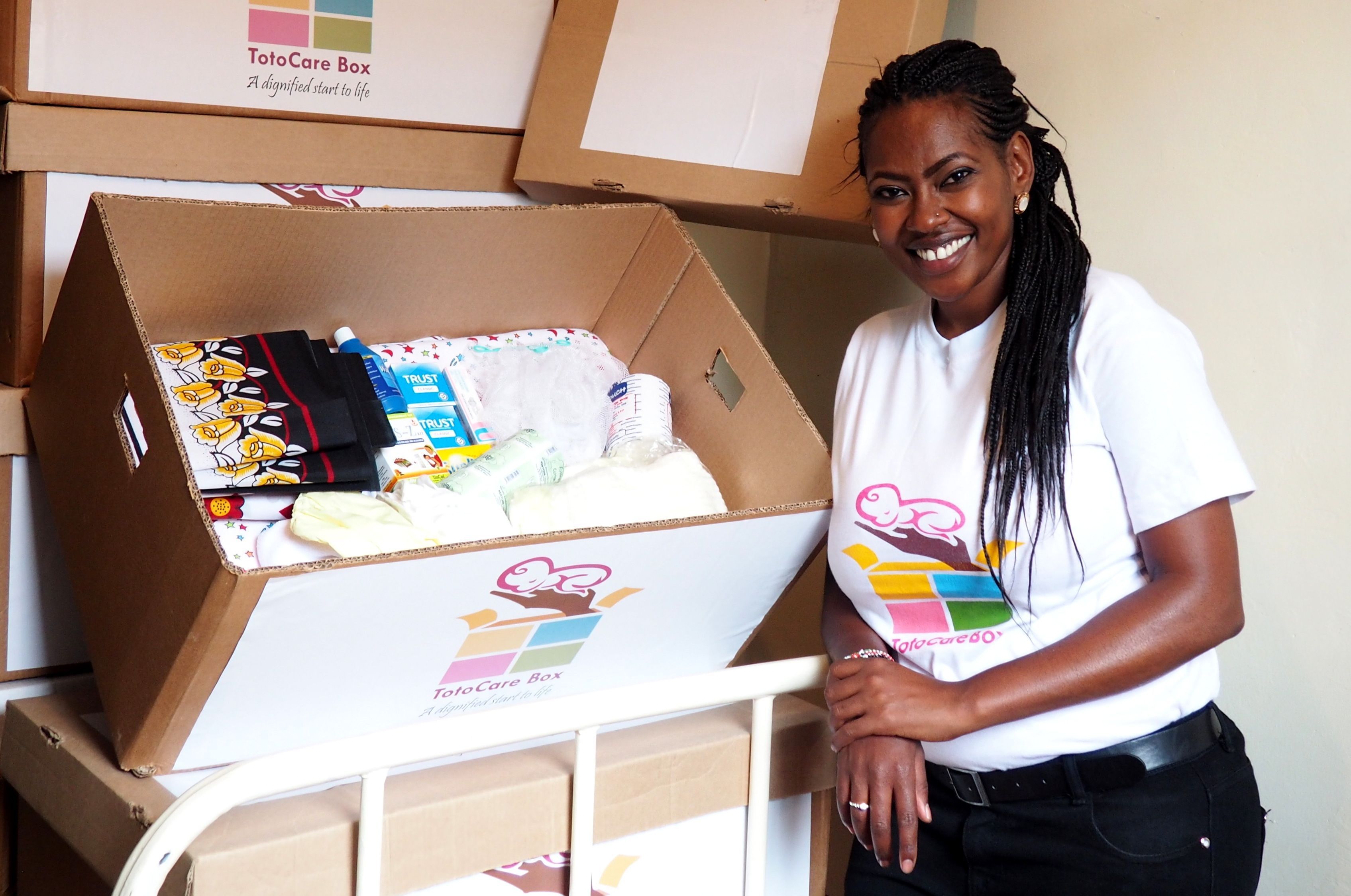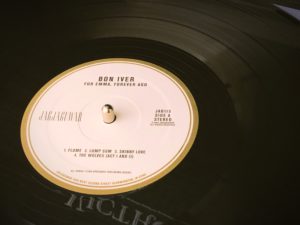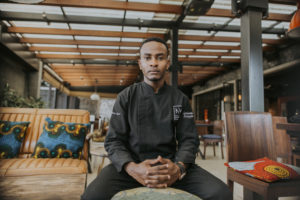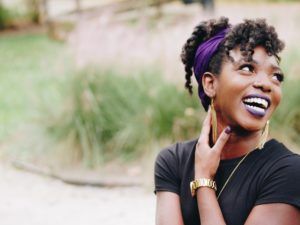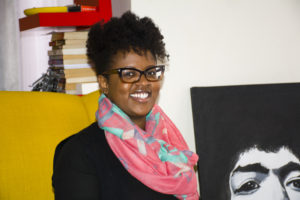BY FLORENCE BETT
It’s November. In a month’s time, 39 new babies born in Kenya would have died; that’s, 39 newborns out of every 1,000 live births this year. 362 mums would have died, too – in every 100,000 live births, 362 mums would have died. These are 2014 stats from the Kenya Demographic and Health Survey. Their stats also say that only 58 per cent of pregnant women make the recommended four or more antenatal care visits to a clinic.
“Poor babies,” I say, seething from the maternal stab that makes my heart bleed whenever I come across any material that speaks of such. “Why do they die?”
“Four major causes,” Lucy says. She pokes her index finger into the air. Her clipped fingernails have weary carelessness of someone that works a lot with their hands. “Because they get cold and the hypothermia causes pneumonia; they also die from diarrhoea; from malaria from getting bitten from mosquitoes and from neonatal sepsis.”
(I mentioned to you that I’m reading this book by David Nicholls called Us, yes? It’s about an English couple and their teenage son. They had a daughter that died soon after birth, a day after, probably. She died from sepsis. What Lucy says makes sense to me now. Just thought to mention that quickly to you.)
In July 2016, Lucy and three of her childhood pals – Jackie, Wanja and Angie – sat around a table and drew up the blueprints for Lucy’s idea, the idea to mitigate the risks that contribute to infant mortality. They looked at these four major causes of newborn deaths and asked themselves how they could significantly reduce these statistics. Reduce them to even zero, hopefully. They also asked themselves how they could get mums to make their minimum four ANCs (antenatal care visits) and give birth at a health facility.
These whats and hows were the push factor for Toto Care Box Africa.
Let’s pause here so you can meet the girls: Lucy Kaigutha is 32 and is the founder of the start-up. She’s the one that came up with the idea for Toto Care Box. She pulled in her pals – all in the health industry – to journey with her on this quest to reduce the damning statistics.
There’s Dr Angela Kavila-Kwinga, she’s trained as a pharmacist but now handles marketing and PR. She’s also Lucy’s big sister. (I’d later meet their Mum and see where she got her heart-shaped face from.) Helen Kariuki is a public health graduate, she now manages finance. She listens more than she speaks, and didn’t say much on that day. Dr Jacqueline Gachihi is another pharmacist, deals with wellness and nutrition, she now oversees operations. They’re all 42.
I meet the girls at Toto Care’s office off Ole Odume Road. We all sit around a table in the boardroom and chat over hot mugs of herbal tea. It was lovely.
Toto Care Box gives away those carton boxes you see up there to mums in the slums who have just given birth. But there’s a catch to who gets the box and who doesn’t. Lucy says, “Only mums that have finished their four ANCs and give birth at a health facility can get the box. During the ANCs, the mum-to-be is trained on how the use the box plus the items in it, safely and correctly.”
“The box is also a crib for the baby to sleep in, but,” she says with cautionary tone, “only until the baby is three month old. Because then he starts moving around in the box and he can move it until it topples over. The box is no longer safe for him past three, four months.”
“Also because they outgrow the box?” I jump in and offer. Lucy nods. It makes me think back to Muna and her Moses Basket, and how she started to flap and wave her arms frantically in the basket, irritated, and how she’d pull at the mosquito net until it had covered her little face. At four months, I kept the Moses Basket away and moved her to sleep in her bed (sometimes) and to mine (mostly). I am happy to announce that she eventually left and has been sleeping in her own bed since. Clap, clap.
“What’s the box for after those three months?”
“Mostly for storage,” Lucy says. “The mum can put clothes or other items for the baby inside it.”
I want to ask why they can’t make a bigger box but then I remember that their agenda is to preserve life in the first 28 days of a baby’s life, not to offer a sleeping solution to a wriggling infant.
“Do you ask some mums to bring back the boxes so you can reuse them?”
“No, no we don’t.”
“Oh, OK. And out of curiosity, Lucy, tell me, how high and deep is this box, what does it measure?”
Slowly, Lucy says, “70cm by 43cm by 27cm.”
Lucy tells me about the items that go in the box. “These 18 essential items are guaranteed to protect the baby’s in its first 28 days. They are low cost, high impact items.”
She stands and moves over to the sample box that’s been sitting idly behind us, waiting its turn. I imagine how excited it must be to finally get centre stage.
“We have a water-proof mattress, an under sheet, a full set of baby clothes and a blanket to keep the baby warm; those items take care of the hypothermia and pneumonia. There’s cotton wool and an antiseptic cream called Chlorhexidine for cord care; that’s for neonatal sepsis. There’s Sunlight bard soap for promoting hand-washing and hygiene, and Aquaguard for disinfecting drinking water. That addresses diarrhoea. Also, there’s DTS-Z kit, that satchet you see there, that’s a zinc combo for dehydration in case of diarrhoea, only to be given from two months. A mosquito net to drape over the box when the baby is sleeping inside, that’s to prevent malaria. Condoms for birth spacing and safe sex –”
“Although condoms don’t really address the stats you mentioned earlier…?”
“No, ha-ha,” says Lucy. “Especially not to the younger couples. But it introduces the conversation of long-term family planning to these mums.”
I stand over the box and examine the items inside, taking each one and feeling them in my hands. There are a million and one other items any urban mum like myself would like thrown into that box: Sudocrem, Olive oil, Milton’s sterilizer, Avent bottles and pump, nail clippers, baby wipes, Vaseline… Hell, someone get me a stroller to put the entire box into.
But Lucy and the girls applied a discerning thoughtful process to decide what goes in the box and what doesn’t. Before we get into that, let me tell you more about Lucy before she went into Toto Care.
Lucy has an undergrad and masters degree in Public and Maternal Health, and International Development. She graduated from the University of Sheffield, UK, in January 2012. She relocated to the UK in 2006. She spent the next two years after her graduation selling insurance and furniture online, a host of odd jobs, really. She returned home in September 2014.
Like most Kenyans making the shift back home, Lucy had a blinding confidence that she would readily get a perks-ful jobo no sooner had she finished unpacking her suitcases. But all she got was internship, frustration and volunteer work. Si you know how it goes?
Lucy recalls, “I’d been to West Pokot in 2011, with my school, for a two-week international field class in maternal child health and saw this mother in Marich Village – mid 40s, four children, all below 12 and a newborn, absolute poverty – and you could tell she’d not had lunch that day. Her husband was away. I had a litre of water, a chocolate bar and a fruit in my bag, and we’d signed these ethical forms saying we won’t give anything as incentive because it may affect your research. She asked, Utaniachia kitu kidogo? And I couldn’t. I wished I could do more for her.
“In late 2015, I’m back home and I stumbled upon an article on Facebook, on the BBC website, ‘Why Finnish babies sleep in card board boxes’. The Finnish had been practising this for 75 years. Their box had 111 items and because of it, Finland has the lowest infant and maternal mortality in the world. I thought, Why not come up with a similar box but for the needs of mothers and newborn babies in poor and marginalized communities here in Kenya?”
Lucy pulled in her three pals to make things happen. Jackie, Angie and Wanja. They’re all in the health industry. They too had studied abroad and had returned home to the disillusionment of the local job market. Angie and Jackie both got entry-level government jobs; they tell me about their experiences burrowing away in the rabbit holes that shape government institutions. Wanja, though, she landed at the airport and was managing Toto Box finances before she even knew it.
For the first six months of 2016, Lucy and the girls built the concept for Toto Care. They had focus groups discussions with new mums in the slums, and consultations with midwives, paediatricians and the Ministry of Health. That’s how they zeroed in on the 18 items that ended up in the box.
“When did you give away your first kitted box?”
“That December,” Lucy says.
“To whom?”
“You see the lady who brought in the tea?” Jackie says. “We gave the first box to her daughter, she’d just given birth in Kenyatta Hospital but she lost her baby a few days after. It was sad. Really sad.”
“And how many boxes have you give away to date?”
“82 as of last week.” [The week before 27 June.] Angie adds, “Our goal is to give away one million boxes and save one million babies.”
I pause as I think through the practicalities of these give-aways.
I chew on the bottom of my lip and ask, “So what’s the total cost of the box and all the items in it? How are you guys financing them?”
“3 thousand bob for each box,” says Angie. “We’ve been financing it from our own pockets and through crowd funding. We’ve raised about 300k so far. Think you can,” she pauses cheekily and adds with bright-eyed optimism, “think you can write our M-changa Paybill number in the story? It’s 891300, account number is ‘TOTOCAREBOX’, no spacing, all caps.”
I chuckle. “Why not? Ha-ha.” I add, “And where do you get these items from, especially the box, where do you buy it from?”
“It’s made by some guys in Kariobangi,” Angie says. “And most of the other items we buy from Eastleigh in Garissa Lodge. The cream and salts are from government clinics.”
“And which slums have you worked with, which mums are you working with now?”
Lucy says, “We’ve worked with mums from Mukuru Kayaba, Mukuru A and B, Fuata Nyayo A and B, Landi Mawe. But until we can get more financial support, our focus for now is on Mukuru Kayaba.”
Giving away the box to a mum and her newborn is one thing. In the past year, the girls have also realized that they cannot isolate the immediate needs of the newborn from that of its mother.
Angie says, “At the follow-ups, you find mothers with issues like alcohol and substance addiction, gender-based violence, teenage mums… We cannot say we will look after the baby for 28 days and ignore the condition of the mother. Our plan is to partner with people offering counselling, long-term family planning solutions, elevating safe motherhood, proper breastfeeding, wellness to preserve life, basically…” She trails off. “So that by the time we are going into the community, we are offering these mums a robust package.”
I’m curious to see how the groundwork is done. So I join Lucy the next day to deliver 11 boxes to Lengo Medical Clinic. It’s in Mukuru Kayaba slums, in Lucy’s backyard in South B.
It’s a Wednesday. It’s a gray morning and the sky is hanging low. I get to Lucy’s place at 10AM. I find that she’s already kitted the boxes and stacked them at her front door; she’s waiting for the mkokoteni guy to collect them for dispatch to the clinic.
Lucy invites me into the digs. Her Mum fixes me a cup of tea and bread, I have it in the kitchen table and chat Lucy up as we wait. She tells me about her sisters and late brother, about her nieces and nephews, about her years abroad in the UK and relocating back home, about that transition, about the struggle to progress their agenda at Toto Care, about scaling up the model when they expand, about the plight of mums whenever she makes follow-up visits to the slums.
“I cried the first time I saw a real baby sleeping in our boxes,” Lucy says, the gap in the front teeth showing. “I used to have sleepless nights sometimes. I remember this mum I was doing a follow-up in Mukuru Fuata Nyayo who told me that because of the box her baby is safe from cockroaches and rats that used to enter her house at night from the holes in the walls, and go to her baby. I saw the holes, it was horrific, she literally lived in a cave. It was a makeshift mabati that was carved inwards and a makeshift mattress…That really pulled me apart.”
Lucy still has traces of a Bri’ish accent, and she starts and ends her phone calls with the word ‘Love’. “Alright, Love… I’ll be waiting for your email then… Bye, Love.” “Hallo, Love… Yes, I’m here with her right now… We’re having breakfast.. Yeah, yeah, he said he’s on his way… OK, Love.”
It’s 12.30PM when the mkokoteni guy shows. Lucy and I take a round route to get to Mukuru Kayaba. It takes us about 30 minutes. Lucy is an engaging conversationalist and I barely notice when the orderliness of suburbia slips away and we slide into the mayhem of the slums. I’d not been Mukuru Kayaba before. There was really no harm around us but I was too skittish to pull out my camera and take some shots.
The clinic itself is a skinny four-storey concrete structure opened in October 2016. The wards inside are clean and in prim order. Mums-to-be make their ANC visits and deliver here, all free of charge – all this is part of the Linda Mama initiative by the government.
The hospital admin – Jackson Chepkonga – receives the boxes then shows us around the clinic. He’s a pleasant warm chap. I can tell that he loves his job and that he’s happy with how far the clinic has come. He tells us that eight mums were discharged that morning. (Later, when he’s walking us out, he buys us chapos from some den down the road.)
Lucy and I get to meet one of them and her newborn. Mum’s name is Irene Adhiambo – she’s 35, four kids now (her three sons are 18, 15 and 12). Her newborn daughter, Gabriella, is two weeks old. The family lives in a single-room house. We didn’t get to go to her house but I really wish we had. I really do.
Irene is holding Gabriella in her arms as we speak to her. We ask her about the box and what she likes about it, “Napenda box kwa sababu mtoto anaeza lala ndani bila kusumbuliwa na hao wengine, wanachezanga sana saa zile amelala hapo kwa kitanda. Akilala kwa box pia naeza endelea na kazi za nyumba.”
Irene speaks sparse and we have to ask her leading questions to get her to share her experience with the box. Plus my ‘Swa writing really isn’t making it any easier for you, is it? Hehhe.
She nods her head slowly and says when I ask, “Eeehh, usiku inasaidia sana mtoto asikulwe na mbu. Ata hiyo cream ni poa sana. Na blanketi pia cause mtoto hasikii hii baridi.”
Reach Toto Care Box
Website: www.totocarebox.org
Phone number: 0719313712
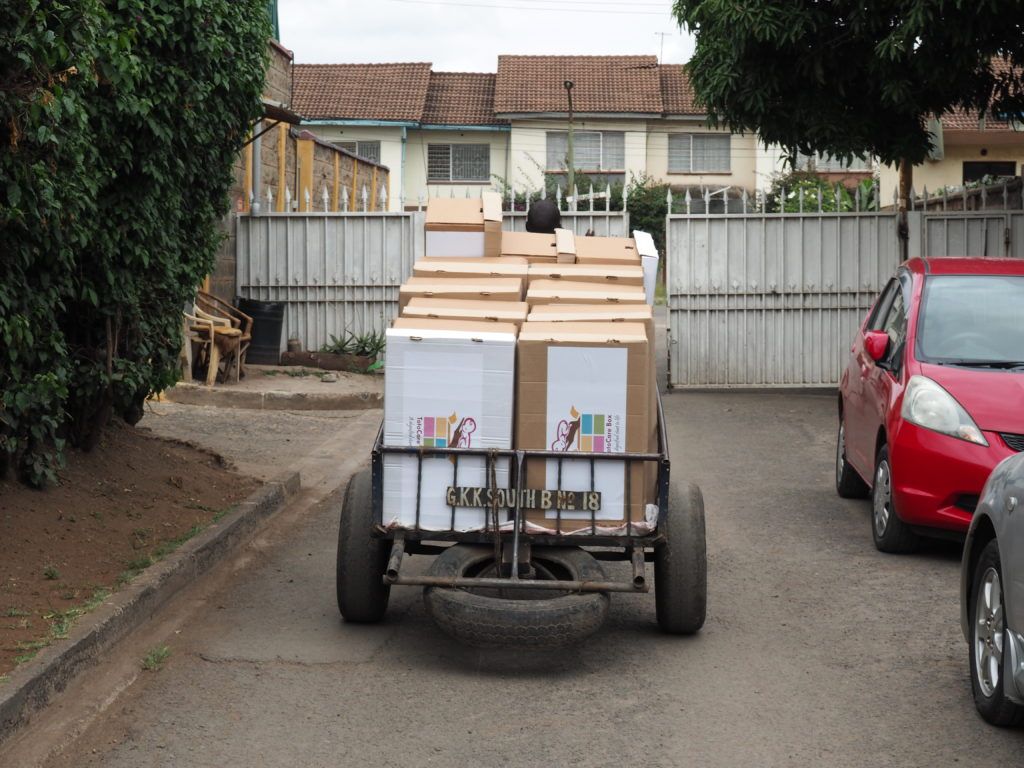
The boxes stashed in the mkokoteni on the way to Mukuru Kayaba
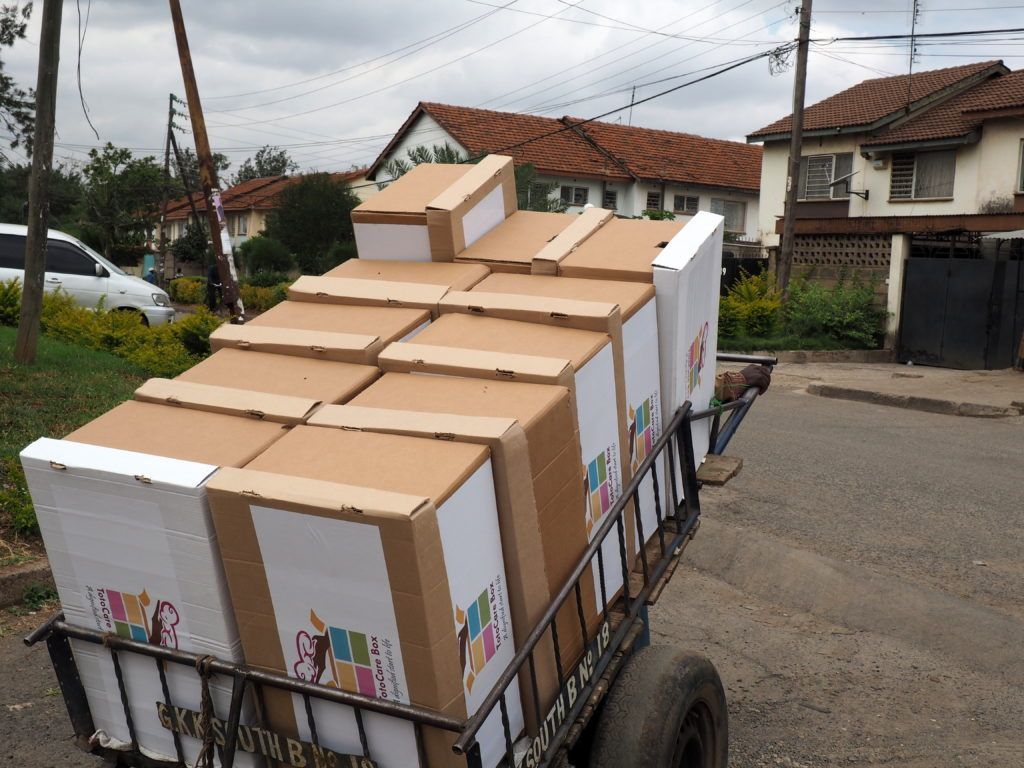
The boxes stashed in the mkokoteni on the way to Mukuru Kayaba
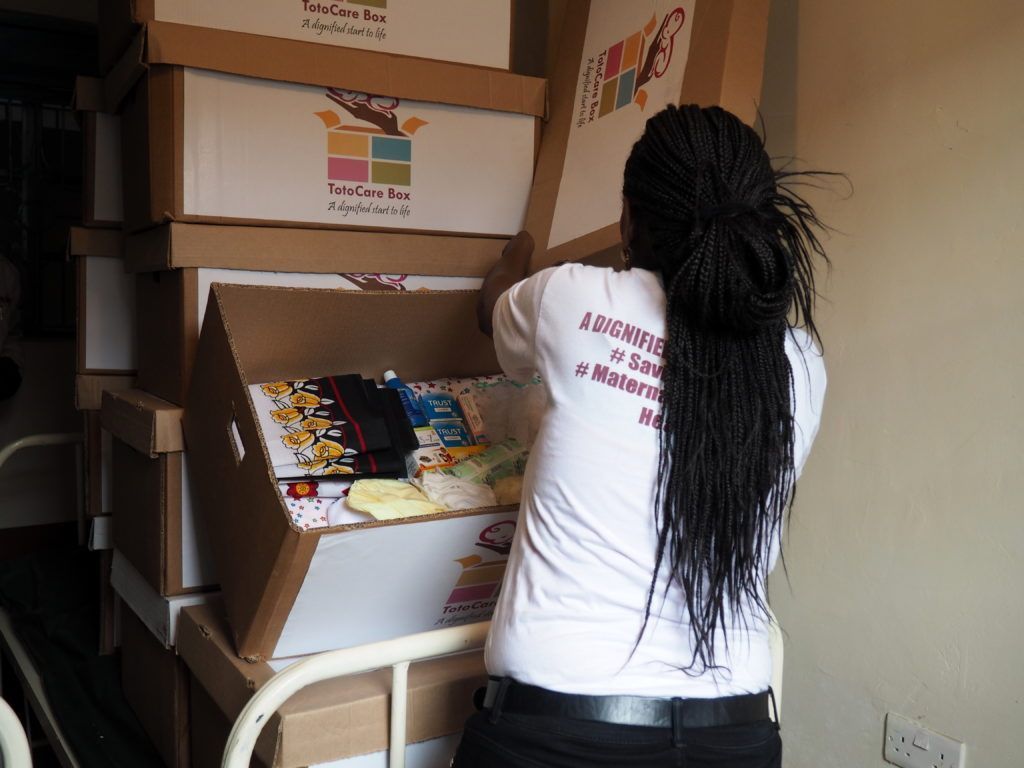
Lucy aligns the boxes for this shot

Lucy debriefs with the Admin, Jackson Chepkonga, at Lengo Clinic
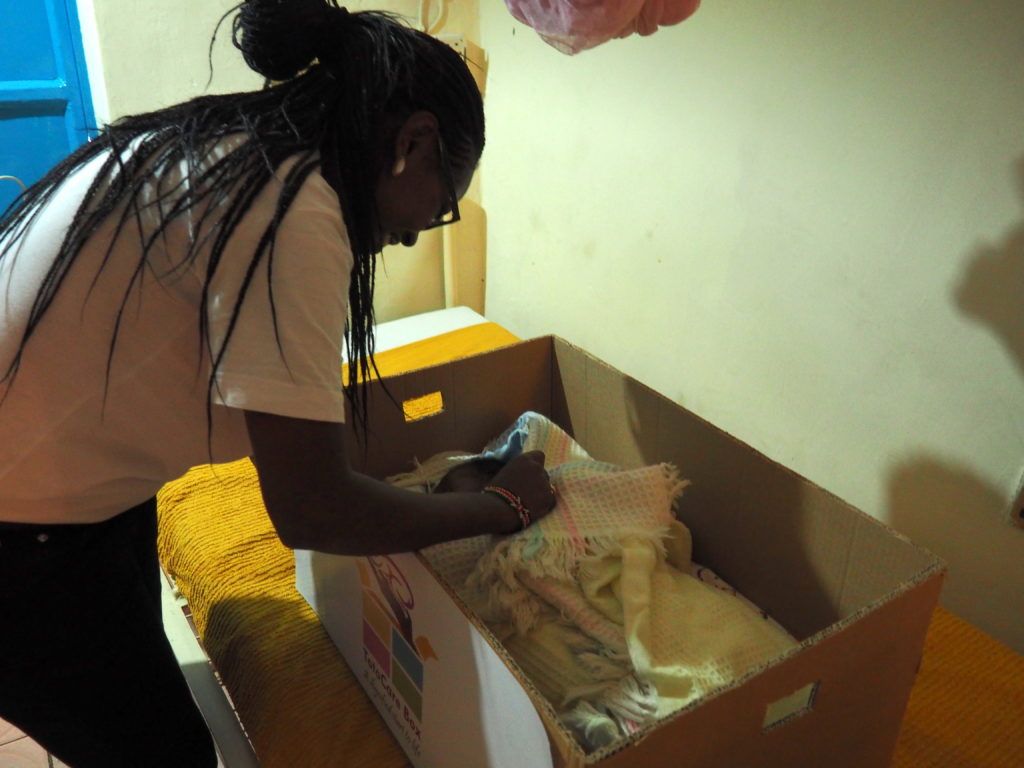
Lucy swaddles Baby Gabriella in her box
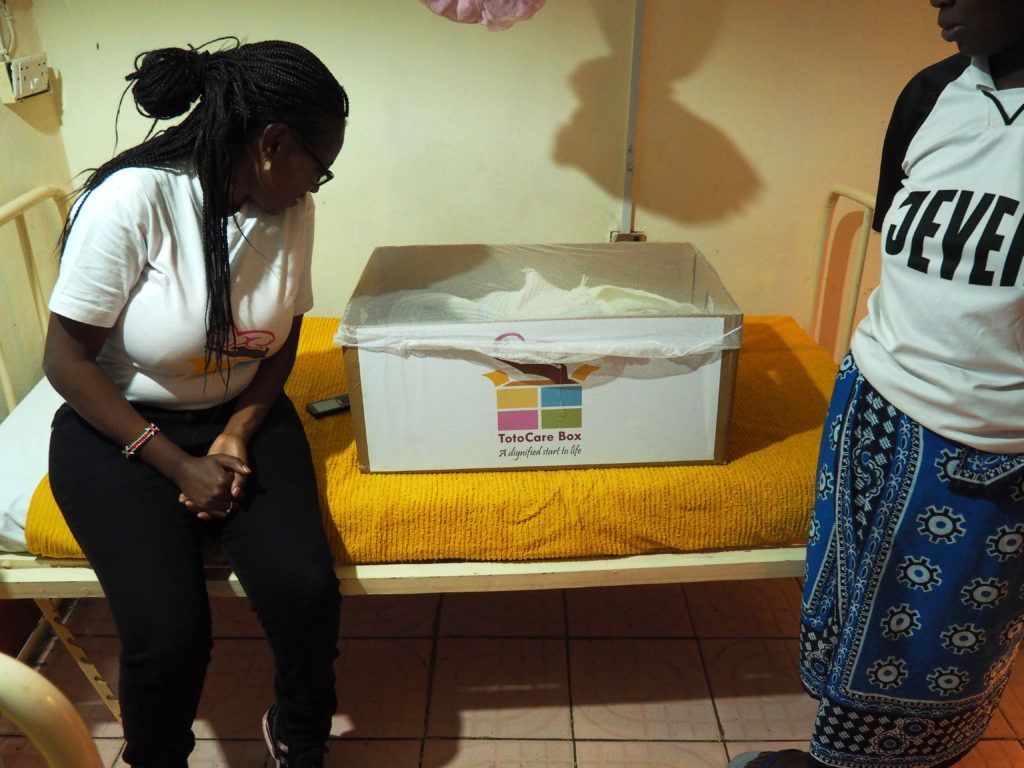
Lucy stares at Gabriella sleeping in the box. Irene, Gabby’s mum, looks over
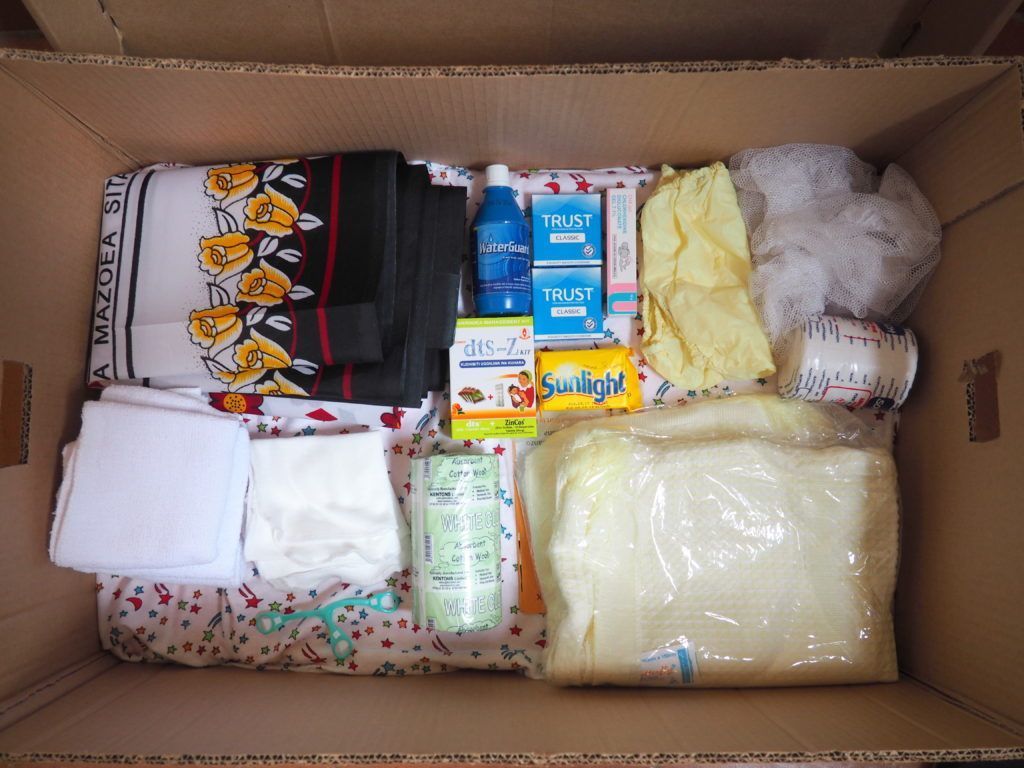
The items inside Toto Care’s box

